



When considering the water treatment process by means of EZV units you should take into consideration several general principles:
. It is more advantageous for the EZV - technique if treated water particle velocity is higher at the place of treatment, i.e. the piping diameter at the place of treatment should be reduced if possible.
. It is important to treat water when it is cold, or prior to its heating. Therefore, the place of water treatment should be located before that of water heating..
. Owing to certain degradation of positive water treatment effects due to mechanical shocks and turbulences, the place of water treatment should be behind a pump, a separator, or a flow meter, and as close to the place of heating as possible.
. Do not forgot, that this treatment technique’s effects are temporary only - treated water keeps its new properties for the period of about 72 hours (depending on chemical composition of water, on the system and its individual components, pressure, gas content, etc.).
. Note that while water treatment by means of EZV units reduces incrustation ( in amorphous condition - rather than solid, incrustations are muddy or slimy), however, they do separate after water heating, mainly at places where the velocity of particles is low, or near to zero. Therefore, it is important for devices with deposited muddy incrustations (boilers, heat exchangers, storage heaters, storage tanks, etc.) to be fitted with an effective desludging unit. If a system (mainly a closed system) is not fitted with a desludging unit, it must be additionally provided with one - a centrifugal separator. At the same time we do suggest to rinse the system out and wash the accumulated muddy sediments out.
. When treating water of up to 90°C a plastic insert - a compact unit, helps to increase the efficiency of the process . Owing to the occurrence of muddy incrustations, pumps should be arranged behind a centrifugal separator, or a suitable filter should be used to avoid the risk of their jamming.
. When treating water of up to 90°C and of hardness above 25°N, the use of a plastic insert - a compact unit EZV...KZ (KP) is a must.
. In the case of higher gas content, water must be degassed prior to treatment itself (e.g., a KS.. degasser).
When utilizing the house waterworks, we do recommend to locate the water treatment system preferably onto the water reservoir outlet in order to achieve higher effectiveness (alt. 1). If it is not possible, locate the water treatment system onto the flow pipe to the water reservoir (alt. 2).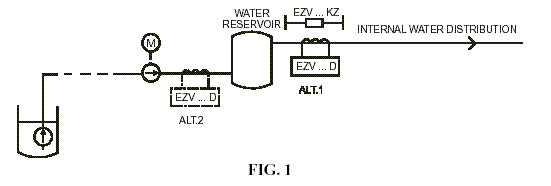
In this case, place your water treatment unit at the connection piping - usually 1“, i.e., EZV 25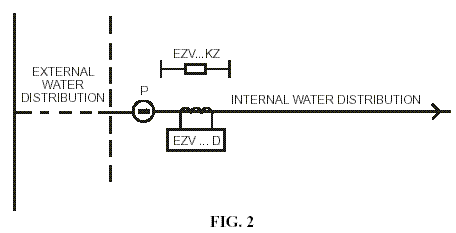
If the hot-water heating system is filled by water not treated chemically, we should anticipate difficulties concerning the seizing of the thermostatic valves, regulating valves (3 or 4 – directional valves), valves switching between the WW heating and radiators, and clogging of the heat transfer surfaces with the highest temperature, i.e. in the boilers. In such case we do suggest to install the EZV physical water treatment system onto the reverse gear of the boiler. If the system is tight or with insignificant water loses, the installed physical water treatment system shall prevent the hot-water heating system from the abovementioned difficulties. In case of significant loses in the heating system or when the system is being discharged, it is advisable to rinse the system out (to wash the muddy sediments out).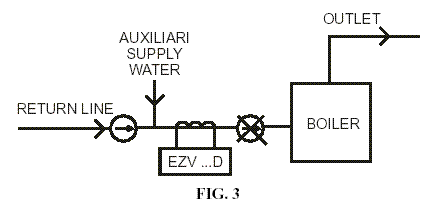
Should it be the case of an old system clogged by incrusts, it is necessary to locate the separator or proper filter onto the boiler inlet with respect to the gradual incrusts removing by means of treated water and with regards to the occurrence of separated incrusts fragments. This is especially important with latest boilers of small water volume and smalldiameter pipes, in which the released softened incrustations can get stuck and subsequently get hardened on the overheated surface.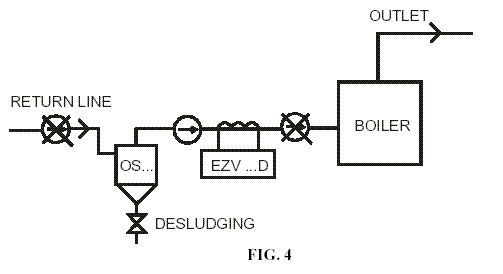
Water treatment by EZV? units depends on a WW heating technique. Given variable water demand, it is recommended to treat inlet water with the EZV...A series units. If water demand changes periodically within 24 hours, or 168 hours (day and week, respectively), you can also apply a unit of the EZV...T, or EZV...MT series, in combination with a suitable timer (can be included in the delivery). For cold water treatment it is recommended to use an EZV...KP(KZ) plastic insert. If a WW outlet has no WW tank, or the tank does not allow for desludging, an OS separator must be integrated into the system. In the case of flow heaters, connect the circulation inlet to the flow heater water inlet to maintain certain minimum flow rate through flow heaters at zero WW demand. In such a case, it is recommended to apply more powerful circulating pumps in the circulation circuit. If your system does not enable you to increase the flow rate in the circulation piping, a circulating pump must be incorporated into the system (dash line in Figure 6). This pump is switched on when the WW demand falls under a specified preset value. In this way, certain minimum flow through the heater is ensured , thus preventing muddy sludge from sedimenting, and moving it to places where it is expected to sediment, i.e., to the WW tank, or the separator. In the case of multistage heating, it is advisable to regulate the heating at individual stages evenly to avoid so-called thermal shocks of heated water due to excessive heating at one stage - this is especially critical at the flow heater stage.
It is advisable to use a separator in the circulation circuit, which especially applies to older (partly incrusted) systems because it removes incrustations released from the system by circulating treated water.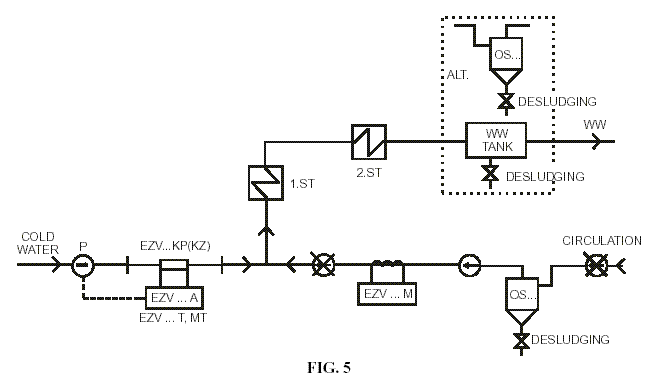
Figure 6 illustrates the above mentioned method of ensuring some minimum flow through stage 1, this being a flow heater which is much more sensitive to incrustations than to storage heating. This design can also be applied to other WW treatment methods. Regular separator, tank, or heat exchanger desludging must be provided for every application.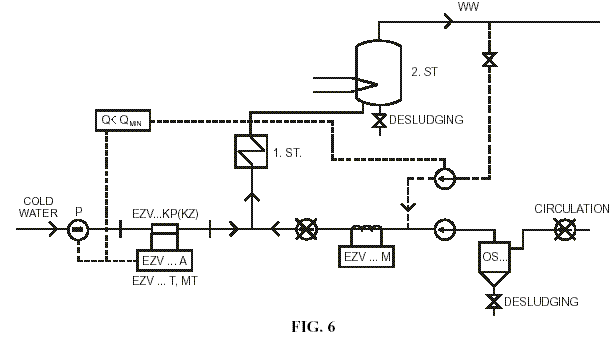
Given the large capacity of storage heaters which fulfil simultaneously the function of a sedimentation component, and are fitted with effective desludging (ball valve), no separator is needed either at the WW outlet or at the circulation circuit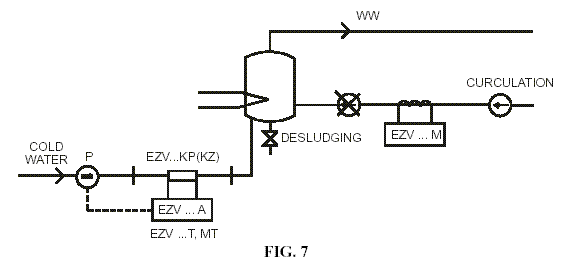
The function of storage heating is implemented by a circuit, including a flow heater and a WW storage tank with a desludging system. The circulation circuit is connected to the flow heater inlet to ensure some minimum flow through the flow heater. If it is not the abovementioned case, the circulating pump located on the accumulation tank is necessary to be controlled in order to p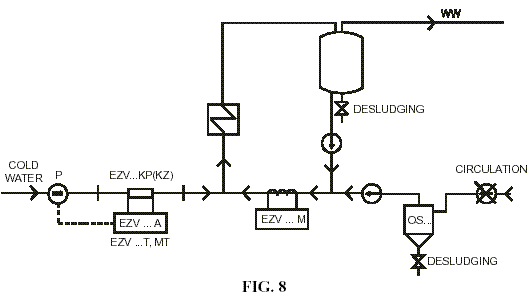 rovide its switching on along with the switching of the exchanger primary winding in time when the heating system is turned on and so that the switching off was implemented with certain time delay after the primary winding of the water heater is turned off. The flow type heater is necessary to be protected against the pieces of incrusts released by the separator in the circulation area. Analogically to the previous case, the volume of the WW storage tank enables it to fulfil also the function of a sedimentation component at the outlet.
rovide its switching on along with the switching of the exchanger primary winding in time when the heating system is turned on and so that the switching off was implemented with certain time delay after the primary winding of the water heater is turned off. The flow type heater is necessary to be protected against the pieces of incrusts released by the separator in the circulation area. Analogically to the previous case, the volume of the WW storage tank enables it to fulfil also the function of a sedimentation component at the outlet.
The first stage (Figure 9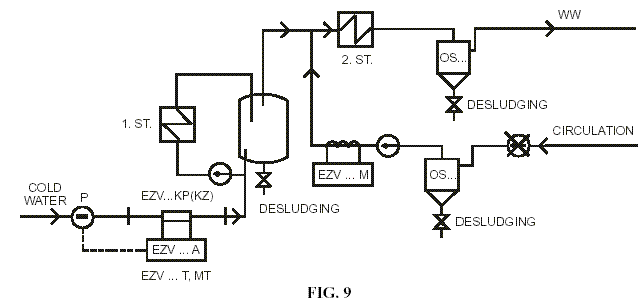 ) is storage heating which makes use of a flow heater and a storage tank which, thanks to its volume, fulfils the function of a sedimentation component, and from which muddy incrustations are discharged during desludging. The second stage represents flow postheating whose input is connected to the circulation circuit. If no storage tank is present at the output of stage 2, a separator must be incorporated for the same reason as in the above mentioned cases.
) is storage heating which makes use of a flow heater and a storage tank which, thanks to its volume, fulfils the function of a sedimentation component, and from which muddy incrustations are discharged during desludging. The second stage represents flow postheating whose input is connected to the circulation circuit. If no storage tank is present at the output of stage 2, a separator must be incorporated for the same reason as in the above mentioned cases.
Small steam boilers The physical water treatment by means of the EZV devices in combination with the chemical water treatment (increase of the feedwater alkalinity) is possible to be utilized in cases of feedwater treatment applied to the steam boilers and steam generators as well. Thanks to the physical water treatment muddy sediments are formed and washed out of the boiler by means of the increased leach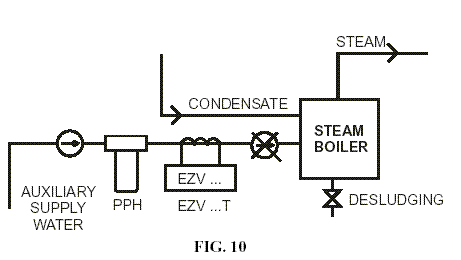 off or more frequent sludge blow-off. The water hardness is thus treated by means of the physical treatment and the corrosiveness in water by the pH increase of the feedwater is treated by means of the chemical water treatment (the most frequent is the use of polyphosphates - PPH). The increased leach off or more frequent sludge blow-off cause the increase of energy loses but on the other hand it is cost effective concerning the operation and increasing expenses (salt etc.) of the traditional ion-exchanging water treatment plants. In some cases it is possible to utilize physical water treatment as the supplementary water treatment so as to provide higher reliability of the steam boilers during operational process. If chemical water treatment fails due to any reason (for example due to shortage of salt necessary for the filters regeneration), in the course of specific time period and under the particular conditions ( increased leach off or more frequent sludge blow-off) it is possible to operate the steam boilers further on thanks to the installed physical water treatment system. Small steam boilers are provided with a separate inlet for condensate and for auxiliary supply water. The flow rate of auxiliary supply water depends on boiler capacity and steam consumption. Units of the EZV... or EZV...T series are usually employed for this kind of application. The boiler must be regularly desludged. Medium-capacity steam boilers
off or more frequent sludge blow-off. The water hardness is thus treated by means of the physical treatment and the corrosiveness in water by the pH increase of the feedwater is treated by means of the chemical water treatment (the most frequent is the use of polyphosphates - PPH). The increased leach off or more frequent sludge blow-off cause the increase of energy loses but on the other hand it is cost effective concerning the operation and increasing expenses (salt etc.) of the traditional ion-exchanging water treatment plants. In some cases it is possible to utilize physical water treatment as the supplementary water treatment so as to provide higher reliability of the steam boilers during operational process. If chemical water treatment fails due to any reason (for example due to shortage of salt necessary for the filters regeneration), in the course of specific time period and under the particular conditions ( increased leach off or more frequent sludge blow-off) it is possible to operate the steam boilers further on thanks to the installed physical water treatment system. Small steam boilers are provided with a separate inlet for condensate and for auxiliary supply water. The flow rate of auxiliary supply water depends on boiler capacity and steam consumption. Units of the EZV... or EZV...T series are usually employed for this kind of application. The boiler must be regularly desludged. Medium-capacity steam boilers
Figure 11 illustrates the method of water treatment for steam boilers whose capacity - 1 t/hour, and for single inlet steam boilers (supply water inlet). Auxiliary supply water is first mixed with condensate then centrifuged in the separator, and finally treated. A separator is needed because released incrustations can be transported by condensate to the inlet.
Since water treatment for high-capacity boilers is application-specific, this Manual cannot present any general scheme. Rather, it gives an example of water treatment for BK8 moderate-pressure boilers whose total installed capacity is over 25 MW. It is recommended to consult your EZV? -based water treatment design for steam boilers of that capacity (consultations are free of charge). The system illustrated in Figure 12 makes use of an original water treatment system, notably a reactor which functions as a sedimentation component, sand filters, a decarbonized water tank, and a supply water tank. Phosphate dosers are the only components taken over from the original chemical treatment system, which resulted from the need to reduce apparent supply water basicity. Owing to supply water demand variations, flow-meter-controlled units (EZV...A series) were applied in supply water feed pipings to individual boilers.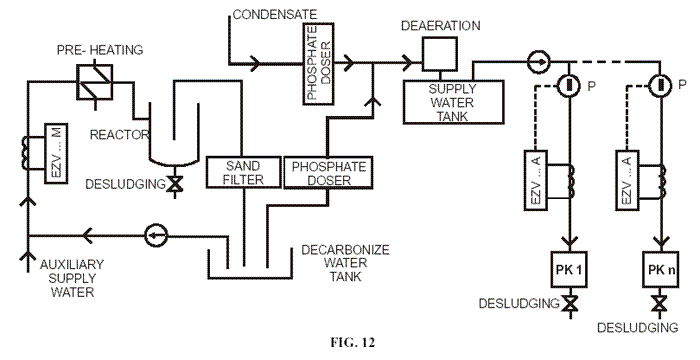
Given the limited time effect of water treatment (72 hours), EZV units in closed systems must be placed in the circulation part to re-treat circulating water. Based on experience, it is advisable to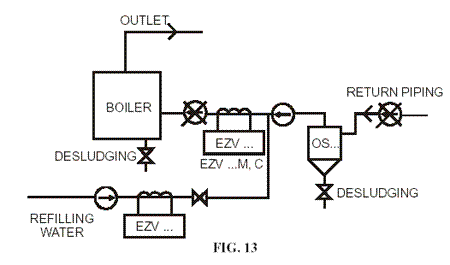 treat also system refilling water even if it appears to be unjustified with regard to the above given description. This chiefly holds for applications characteristic of significant circulating water losses.
treat also system refilling water even if it appears to be unjustified with regard to the above given description. This chiefly holds for applications characteristic of significant circulating water losses.
Water treatment in small systems
It is recommended to treat refilling water in small systems with relatively high water losses. In the case of boilers with small heated water capacity (flow heating), it is advisable to incorporate into the return line a separator even if the boiler is provided with a desludging unit. The separator protects the boiler from released incrustation pieces. For higher capacity boilers (storage boilers), the separator may be omitted - released incrustations get desludged in the boiler.
Time effect of this treatment technique is of considerable advantage in this case. Owing to the total volume of water in the system, and the circulating pump capacity, a water treatment unit may be placed at the retur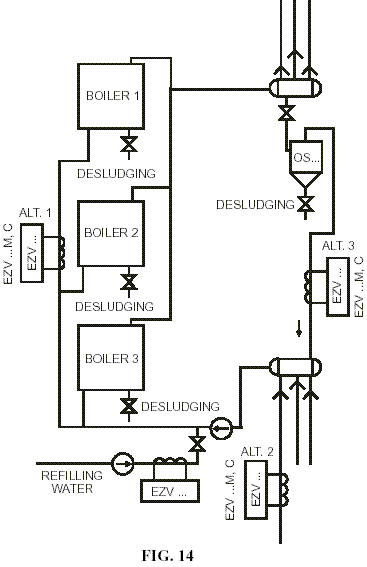 n piping of one of several boilers - ALT1 (the one which is operated continuously) or at one of the return pipings connected to the collector - ALT2. Selection of one of these options depends on calculation, according to which the whole volume of water in the system should pass the point of treatment at least once in 24 hours. Another option consists in artificial closing the heating circuit via a pressure reducing valve, a separator (in the case of higher water hardness or system water losses), and a water treatment unit itself. All the options guarantee appropriate water treatment at lower cost. Critical is regular desludging of the boiler and the separator. Refilling water should be treated in the case of system water losses. Water treatment described for boilers applies analogically to heat exchangers. Figure 15 illustrates another possible water treatment design in closed systems. A centrifugal separator is placed in the main return piping. Treatment itself is applied to pipes of an appropriate diameter. The choice of the diameter depends on the total flow rate Q and the volume of water in the system.
n piping of one of several boilers - ALT1 (the one which is operated continuously) or at one of the return pipings connected to the collector - ALT2. Selection of one of these options depends on calculation, according to which the whole volume of water in the system should pass the point of treatment at least once in 24 hours. Another option consists in artificial closing the heating circuit via a pressure reducing valve, a separator (in the case of higher water hardness or system water losses), and a water treatment unit itself. All the options guarantee appropriate water treatment at lower cost. Critical is regular desludging of the boiler and the separator. Refilling water should be treated in the case of system water losses. Water treatment described for boilers applies analogically to heat exchangers. Figure 15 illustrates another possible water treatment design in closed systems. A centrifugal separator is placed in the main return piping. Treatment itself is applied to pipes of an appropriate diameter. The choice of the diameter depends on the total flow rate Q and the volume of water in the system.
In addition to anti-incrustation effects, water treatment in swimming pools also entail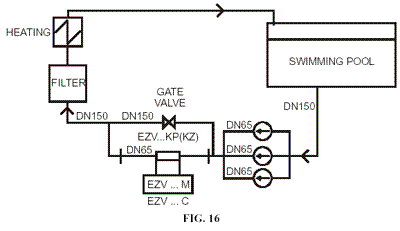 s anti-bacterial effects, which is projected onto lower chlorine consumption (by 30%, the harder the water, the more significant bactericidal effect). This is reflected in improved pool water quality. When water is treated magnetically, which distorts incrusted substance bonds to water molecules, a small amount of hydrogen peroxide precipitates, which, however, very quickly dissolves in water and kills bacteria. Moreover, it produces a layer of FE3O4 on the inner piping surface, which protects steel surface from corrosion. Figure 16 exemplifies water treatment in a swimming pool. Normally, only one circulating pump is operated: the gate valve is closed, which means that all water passes through the water treatment unit. Usually once a week the filters are washed i.e., the direction of water flow through the filters is reversed by valves. During the washing process, all pumps are switched on to produce the required overpressure. The gate valve is open to minimize pressure losses: water does not pass through the place of water treatment. Owing to the fact that the filter washing process takes only about an hour, it does no impair water treatment in the swimming pool. This approach allows for eliminating incrustations and improving the passage of heat through pool water at low cost. Furthermore, chlorine consumption is reduced, which accelerates the return on ivestment into water treatment by EZV? units.
s anti-bacterial effects, which is projected onto lower chlorine consumption (by 30%, the harder the water, the more significant bactericidal effect). This is reflected in improved pool water quality. When water is treated magnetically, which distorts incrusted substance bonds to water molecules, a small amount of hydrogen peroxide precipitates, which, however, very quickly dissolves in water and kills bacteria. Moreover, it produces a layer of FE3O4 on the inner piping surface, which protects steel surface from corrosion. Figure 16 exemplifies water treatment in a swimming pool. Normally, only one circulating pump is operated: the gate valve is closed, which means that all water passes through the water treatment unit. Usually once a week the filters are washed i.e., the direction of water flow through the filters is reversed by valves. During the washing process, all pumps are switched on to produce the required overpressure. The gate valve is open to minimize pressure losses: water does not pass through the place of water treatment. Owing to the fact that the filter washing process takes only about an hour, it does no impair water treatment in the swimming pool. This approach allows for eliminating incrustations and improving the passage of heat through pool water at low cost. Furthermore, chlorine consumption is reduced, which accelerates the return on ivestment into water treatment by EZV? units.